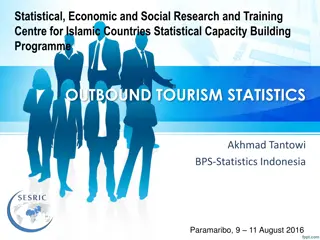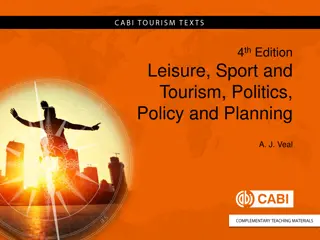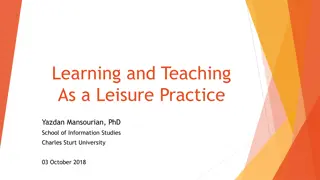Planning and Auditing Facilities in Leisure, Sport, and Tourism
This content discusses the importance of facility/service audits in leisure, sport, and tourism settings. It covers the facility audit process, different types of facilities, capacity estimation, natural and heritage resource assessments, and more. The process involves identifying facilities, assessing their usage and management, addressing demand, and confirming facility deficits. Examples of facility types, including purpose-built, natural/heritage, formal, and informal, are provided to illustrate different contexts where audits are necessary.
Download Presentation

Please find below an Image/Link to download the presentation.
The content on the website is provided AS IS for your information and personal use only. It may not be sold, licensed, or shared on other websites without obtaining consent from the author.If you encounter any issues during the download, it is possible that the publisher has removed the file from their server.
You are allowed to download the files provided on this website for personal or commercial use, subject to the condition that they are used lawfully. All files are the property of their respective owners.
The content on the website is provided AS IS for your information and personal use only. It may not be sold, licensed, or shared on other websites without obtaining consent from the author.
E N D
Presentation Transcript
4th Edition Leisure, Sport and Tourism, Politics, Policy and Planning A. J. Veal
CHAPTER 11 Planning Tool 2: Facility/Service Audit Capacity Leisure, Sport and Tourism, Politics, Policy and Planning, 4th edition, Veal, 2017, CABI Tourism Texts
Outline Introduction The facility/service audit process Facilities: definitions and types Capacity and facility types and contexts Types of capacity Capacity estimation Greenfield sites Natural & heritage resource assessment Programmes and events Leisure, Sport and Tourism, Politics, Policy and Planning, 4th edition, Veal, 2017, CABI Tourism Texts
The facility/service audit process (Fig. 11.1) 1. Identify set of facilities 4. Action Yes Yes 2. Are facilities fully used? 11. Are facilities serving all areas? 3. Can manage- ment correct? No Yes No No 7. Is there evidence of unmet demand at existing facilities? 12. Quantify potential demand in unserved areas 5. Consider reduc- ing capacity? No Yes 8. Quantify 6. Amend inventory or surplus/deficit details 9. Confirm/amend facility deficit 10. Natural areas: resource assessment 13. Examine for consistency with already set targets and amend as appropriate
What Is a Facility? In sport: a single playing area e.g. court or playing field, or a group e.g. a squash centre, or multi-purpose facility e.g. a sports centre In the arts: a single facility e.g. gallery multi-purpose facility e.g. arts centre In tourism: hotel = a multi-purpose facility: accommodation + convention/ballroom facility + fitness centre Leisure, Sport and Tourism, Politics, Policy and Planning, 4th edition, Veal, 2017, CABI Tourism Texts
Facility types examples Purpose-built Natural/heritage Formal Use occupies specified space/time bookings/tickets A. Playing fields, squash courts, theatres B. Organized activities at natural/heritage site e.g. safaris, whitewater rafting, guided tours Leisure, Sport and Tourism, Politics, Policy and Planning, 4th edition, Veal, 2017, CABI Tourism Texts
Facility types examples Purpose-built Natural/heritage Formal Use occupies specified space/time bookings/tickets A. Playing fields, squash courts, theatres B. Organized activities at natural/heritage site e.g. safaris, whitewater rafting, guided tours Informal User does not occupy specified space/time maybe no booking/ tickets C. Urban parks, trails, museums, galleries D. Non-organized use of national parks, forests, beaches, rivers, historic building/sites Leisure, Sport and Tourism, Politics, Policy and Planning, 4th edition, Veal, 2017, CABI Tourism Texts
Capacity 1. Contexts 2. Concepts 3. Factors affecting capacity 4. Types of capacity 5. Estimation of capacity Leisure, Sport and Tourism, Politics, Policy and Planning, 4th edition, Veal, 2017, CABI Tourism Texts
Capacity: 1. Contexts (Fig. 11.2) Leisure, Sport and Tourism, Politics, Policy and Planning, 4th edition, Veal, 2017, CABI Tourism Texts
Capacity: contexts (contd) Leisure, Sport and Tourism, Politics, Policy and Planning, 4th edition, Veal, 2017, CABI Tourism Texts
Capacity: contexts (contd) Leisure, Sport and Tourism, Politics, Policy and Planning, 4th edition, Veal, 2017, CABI Tourism Texts
Capacity: 2. Concepts (Table 11.2) Concept Definition General 1. Theoretical capacity Level of use unconstrained by management 2. Operational capacity Level of use under current constraints 3. Group size No. of persons typically attending together Leisure, Sport and Tourism, Politics, Policy and Planning, 4th edition, Veal, 2017, CABI Tourism Texts
Capacity: concepts Concept Definition General 1. Theoretical capacity Level of use unconstrained by management 2. Operational capacity Level of use under current constraints 3. Group size No. of persons typically attending together Related to period of time 4. Session Typical event e.g. booking, game, performance 5. Person-session/visit One person attending one session 6. Visitor hour One person attending for one hour 7. Peak period use No. of persons entering in a peak period 8. Beds/bed-nights No. of persons accommodated in a tourist site for one night Leisure, Sport and Tourism, Politics, Policy and Planning, 4th edition, Veal, 2017, CABI Tourism Texts
Factors affecting capacity: physical (Table 11.3) Factor Definition Size natural Physical size (no sport specifications applicable) e.g. beach, river, lake Size design Non-sport: area set aside for leisure e.g. area of urban/national park Sport: specifications e.g. size of a court, number of players Site design Physical features which facilitate visitor use e.g. shelter, traffic management Infrastructure quality Ability of infrastructure to stand wear and tear e.g. quality of footpath surfaces Sustainability of resource Point at which significant/irreversible damage caused to the resource Leisure, Sport and Tourism, Politics, Policy and Planning, 4th edition, Veal, 2017, CABI Tourism Texts
Factors affecting capacity: regulation/management Factor Definition Safety Regulations relating to human safety e.g. weight-bearing, fire exits, pool life- saving Management Effect of management practices on use levels e.g. marketing, customer service, staffing, pricing, maintenance Leisure, Sport and Tourism, Politics, Policy and Planning, 4th edition, Veal, 2017, CABI Tourism Texts
Factors affecting capacity: user attitudes/behaviour Factor Definition On-site user activity Nature of leisure activity taking place e.g. walking, use of motor vehicles On-site user behaviour Impact-creating practices e.g. fire, domestic pets, noise Social custom Socially determined practices e.g. seasonal nature of activities User perception of crowding Sense of crowding may limit use levels e.g. at beaches, ski slopes: length of queues Leisure, Sport and Tourism, Politics, Policy and Planning, 4th edition, Veal, 2017, CABI Tourism Texts
Factors affecting capacity: neighbours Factor Definition Neighbourhood impacts 1. Neighbouring land uses e.g. noise, pollution, access 2. Facility impact on neighbours e.g. noise, access Leisure, Sport and Tourism, Politics, Policy and Planning, 4th edition, Veal, 2017, CABI Tourism Texts
Capacity: 4. Types (Table 11.4) Physical capacity number of people who can fit into space available Operational capacity number of people who can be accommodated, subject to social, organizational, safety, etc., constraints Economic capacity level of uses that optimizes returns or keeps within budgetary limits Social/psychological capacity level of use that optimizes visitor enjoyment (in tourist resorts also considers resident impacts) Ecological capacity level of use that maintains ecological status at acceptable level Tourism capacity in multiple-facility destination: capacity limits of all the above Leisure, Sport and Tourism, Politics, Policy and Planning, 4th edition, Veal, 2017, CABI Tourism Texts
Psychological capacity example (Fig. 11.3) 1000 6.0 900 5.0 Average individual satisfaction 800 Aggregate satisfaction 700 4.0 600 500 3.0 400 2.0 300 200 1.0 100 0 0.0 20 100 200 Persons present 300 400 500 600 Aggregate satisfaction Avge individual satisfaction Leisure, Sport and Tourism, Politics, Policy and Planning, 4th edition, Veal, 2017, CABI Tourism Texts
5. Capacity estimation Formal facilities Informal facilities purpose-built natural/heritage Tourism destinations Leisure, Sport and Tourism, Politics, Policy and Planning, 4th edition, Veal, 2017, CABI Tourism Texts
Capacity estimation: formal facilities: method (Table 10.5) A. Time available (hrs/week) B. Time utilized (%) C. Length of session (hrs) D. Group size (persons) E. Capacity in sessions/week (A x B/100)/C F. Capacity in person-sessions/week (E x D) Leisure, Sport and Tourism, Politics, Policy and Planning, 4th edition, Veal, 2017, CABI Tourism Texts
Capacity estimation: formal facilities: examples (Table 11.5) A B C D E F Facility type Time hrs Time % Session length Group size Capacity: sessions/wk Capacity: persons/wk (A x B/100)/C (E x D) Grass playing field Poor drainage, no lights 10 100% 2 hrs 30 5 150 Good drainage, no lights 28 50% 2 hrs 30 7 210 Good drainage, lights 28 80% 2 hrs 30 11 330 Leisure, Sport and Tourism, Politics, Policy and Planning, 4th edition, Veal, 2017, CABI Tourism Texts
Capacity estimation: informal: purpose-built The example of urban parks (Box 11.1) A neglected topic The myth of under-used urban parks (Gold, 1972) 4 suggested approaches: 1. Personal/social space (Gedikli and Ozbilen, 2004) 2. Satisfaction and perceived crowding 3. Equity (with formal facilities) 4. Cost-benefit analysis see Ch. 12 Leisure, Sport and Tourism, Politics, Policy and Planning, 4th edition, Veal, 2017, CABI Tourism Texts
Capacity estimation: informal: purpose-built: urban park: 1. Personal/social space (Gedliki and Ozbilen, Fig. 11.4) Individual park user individual s social area radius x group social privacy limit Space required per person: 15.7 sq.m or 0.16 hectares per 100 visitors r r r x r r r r Two groups A group of 4 individuals Leisure, Sport and Tourism, Politics, Policy and Planning, 4th edition, Veal, 2017, CABI Tourism Texts
Capacity estimation: informal: purpose-built: urban park: 2. Satisfaction/perceived crowding (using Fig. 11.3) Capacity 1000 6.0 900 5.0 Average individual satisfaction 800 Aggregate satisfaction 700 4.0 600 500 3.0 400 2.0 300 200 1.0 100 0 0.0 20 100 200 Persons present 300 400 500 600 Aggregate satisfaction Leisure, Sport and Tourism, Politics, Policy and Planning, 4th edition, Veal, 2017, CABI Tourism Texts Avge individual satisfaction
Capacity estimation: informal: purpose-built: urban park: 3. Equity Base informal park/open space requirements on the principle of equity with formal provision: e.g. if space for formal sport activity accommodates 200 visits per hectare per week, then 1 hectare should be provided for every 200 informal urban park visits. Capacity estimation: informal: purpose-built: urban park: 4. Cost-benefit analysis Provide facilities up to the point that benefits no longer exceed costs see Chapter 14 Leisure, Sport and Tourism, Politics, Policy and Planning, 4th edition, Veal, 2017, CABI Tourism Texts
Capacity estimation: informal: natural/heritage Includes: i. multiple use outdoor areas, e.g. forests ii. protected areas, e.g. national parks, wilderness iii. beaches and lakes iv. historic sites Often managed/planned by a specialist agency, e.g. National Parks or Forest Service Balancing competing interests/values Leisure, Sport and Tourism, Politics, Policy and Planning, 4th edition, Veal, 2017, CABI Tourism Texts
Capacity estimation: informal: natural/heritage: recreational carrying capacity : context: balancing competing interests(Fig. 11.5) Conservation values Agriculture Resource Leisure demands Mining/ quarrying Residential/ industrial/ infrastructure development Leisure, Sport and Tourism, Politics, Policy and Planning, 4th edition, Veal, 2017, CABI Tourism Texts
Capacity estimation: informal: natural/heritage: leisure activities Highly specialized activities: e.g. fishing, water sports, skiing, bird watching: each case unique Walkers: including long-distance with camping: impacts depend on numbers Sightseers: typically confined to defined areas, with car parking, etc. (+ picnicking): existing capacity related to car parking spaces, but number of sites and scale present the challenge Leisure, Sport and Tourism, Politics, Policy and Planning, 4th edition, Veal, 2017, CABI Tourism Texts
Capacity estimation: informal: tourism destination Context: multiple attractions, public and private infrastructure (hospitality, transport, water/sewerage, etc.) each with their own current short-term and long-term capacities Example of Venice (Box 11.2) Leisure, Sport and Tourism, Politics, Policy and Planning, 4th edition, Veal, 2017, CABI Tourism Texts
Capacity estimation: informal: tourism destination: Venice: Canestelli and Costa (1991) Constraints on visit numbers: hotel beds non-hotel beds lunches (restaurant capacity) car parking water transport (from car parks to city) solid waste St Mark s Basilica (main attraction) spend per day Leisure, Sport and Tourism, Politics, Policy and Planning, 4th edition, Veal, 2017, CABI Tourism Texts
Table 11.7: Tourism capacity constraints in Venice Capacity Max. Operational % No. Hotel beds 11,000 80 9000 Non-hotel beds 4000 40 4000 Lunches 40,000 62.5 25,000 Car-parking (persons) 30,000 50 15,000 Water transport (trips) 40,000 75 30,000 Solid waste (kg) 60,000 50 30,000 St Mark s (visits) 15,000 66.7 10,000 Leisure, Sport and Tourism, Politics, Policy and Planning, 4th edition, Veal, 2017, CABI Tourism Texts
Table 11.7: Tourism capacity constraints in Venice Capacity Consumption impact Max. Operational Per visitor per day % No. TH TNH DT Hotel beds 11,000 80 9000 1.0 Non-hotel beds 4000 40 4000 1.0 Lunches 40,000 62.5 25,000 1.0 0.75 0.5 Car parking (persons) 30,000 50 15,000 0.33 0.33 0.75 Water transport (trips) 40,000 75 30,000 1.0 1.0 2.0 Solid waste (kg) 60,000 50 30,000 2.3 2.0 1.5 St Mark s (visits) 15,000 66.7 10,000 0.4 0.3 0.7 Spend per day (lira, 1984 prices) - 221.0 85.4 149.0 TH = tourists staying in hotel NTH = tourists staying in non-hotel accommodation DT = day-trippers Leisure, Sport and Tourism, Politics, Policy and Planning, 4th edition, Veal, 2017, CABI Tourism Texts
Table 11.7: Tourism capacity constraints in Venice Capacity Consumption impact Optimal Max. Operational Per visitor per day % No. TH TNH DT Total Hotel beds 11,000 80 9000 1.0 9780 Non-hotel beds 4000 40 4000 1.0 1460 25,000 Lunches 40,000 62.5 1.0 0.75 0.5 10,875 15,000 Car parking (persons) 30,000 50 0.33 0.33 0.75 3709 30,000 Water transport (trips) 40,000 75 1.0 1.0 2.0 11,240 30,000 Solid waste (kg) 60,000 50 2.3 2.0 1.5 25,414 10,000 St Mark s (visits) 15,000 66.7 0.4 0.3 0.7 4350 Spend per day (lira, 1984) - 221.0 85.4 149.0 Optimum solution Visitors (no.) 9780 1460 10,857 22,097 Total expenditure (lira) 2,286,064 Leisure, Sport and Tourism, Politics, Policy and Planning, 4th edition, Veal, 2017, CABI Tourism Texts
Capacity estimation: informal: tourism destination: Sydney From 2002 New South Wales Tourism Masterplan: visitors expected in 2020 in Sydney CBD: 220,000 per day = 30% increase on 2001 700,000 Sydneysiders (commuters, shoppers, residents) implications: additional: passengers through Sydney airport hotel and other accommodation transport and police protection measures for environmental/social attractions spread of visitor attractions/experiences spread of visitors beyond CBD, incl. western Sydney Leisure, Sport and Tourism, Politics, Policy and Planning, 4th edition, Veal, 2017, CABI Tourism Texts























